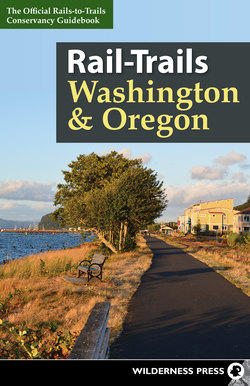Читать книгу Rail-Trails Washington and Oregon - Rails-to-Trails Conservancy - Страница 10
На сайте Литреса книга снята с продажи.
ОглавлениеIntroduction
Of the more than 1,900 rail-trails across the United States, 42 are highlighted in Rail-Trails: Washington and Oregon. These paths tread storied routes of westward expansion and industrialization, spurred by timber and coal, and offer a glimpse into life a century ago. They still bear the signatures of their history: tunnels, trestles, raised berms, and depots, communities born and abandoned.
Some of the original railroads in the Northwest served as logging lines through the massive forests of Oregon and Washington. Rail-trails retrace their tracks, as well as those of other passenger and freight lines. Their original purposes and destinations vary, but each of these rail-trails joins past with present, creating a living memorial of the corridors that helped shape the region.
Washington State boasts some of the most rural and unique rail-trails in the country. These are not always the flat and even pathways you might expect from rail-trails; for example, the John Wayne Pioneer Trail (Milwaukee Road Corridor) offers a backcountry adventure as it traverses the state. Complementing these rustic pathways are paved trails, such as the Chehalis Western Trail or the well-groomed Foothills Trail, which features views of Mount Rainier during much of its length.
In a region best known for rain and gray skies, the Olympic Discovery Trail bucks the trend. The trail passes through Sequim, a town shrouded in the infamous rain shadow of the northern Olympic Peninsula. The town claims far less rain than other coastal towns, which makes travel by bike or foot along the route even more enjoyable.
Oregon’s trails are as diverse as the state itself. Its arid central region is showcased along the 17-mile Deschutes River Railbed Trail, while the Astoria Riverwalk is the place to go for those who want to experience the maritime history that the state is equally known for. In addition, the trails in this guidebook range from rural to urban, and many options in between. It may be hard to believe that bike paths in Portland are in the same state as the Lewis and Clark Commemorative Trail, a 7-mile adventure that traverses cliffs above the Columbia River. While only 9 of the 42 trails in this guidebook are in the Beaver State, each one is sure to inspire you and leave you longing to return.
This guidebook includes not one but two trails that have been inducted into the Rail-Trail Hall of Fame. Seattle is home to the Burke-Gilman Trail, a 17-mile corridor that was inducted in 2008. Oregon’s Springwater Corridor earned the distinction in 2011 and is an integral part of Portland’s bike and pedestrian trail network.
No matter which route in Rail-Trails: Washington and Oregon you decide to try, you’ll be touching on the heart of the community that helped build it and the history that first brought the rails to the region.
What Is a Rail-Trail?
Rail-trails are multiuse public paths built along former railroad corridors. Most often flat or following a gentle grade, they are suited to walking, running, cycling, mountain biking, in-line skating, cross-country skiing, horseback riding, and wheelchair use. Since the 1960s, Americans have created more than 22,000 miles of rail-trails throughout the country.
These extremely popular recreation and transportation corridors traverse urban, suburban, and rural landscapes. Many preserve historic landmarks, while others serve as wildlife conservation corridors, linking isolated parks and establishing greenways in developed areas. Rail-trails also stimulate local economies by boosting tourism and promoting trailside businesses.
What Is a Rail-with-Trail?
A rail-with-trail is a public path that parallels a still-active rail line. Some run adjacent to high-speed, scheduled trains, often linking public transportation stations, while others follow tourist routes and slow-moving excursion trains. Many share an easement, separated from the rails by extensive fencing. More than 240 rails-with-trails currently exist in the United States.
